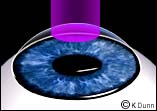PRK
(Photorefractive Keratectomy)
 In PRK, instead of using a diamond-bladed instrument to make incisions in the cornea — as in RK — the surgeon uses a laser to reshape the cornea.
In PRK, instead of using a diamond-bladed instrument to make incisions in the cornea — as in RK — the surgeon uses a laser to reshape the cornea.
The laser removes only a small portion of the thickness of the cornea...about the thickness of 1 to 3 human hairs...so the integrity and strength of the cornea is retained.
Although PRK is still often used to correct mild nearsightedness, the drawback of PRK is that the outer part of the cornea, called the epithelium, is removed while performing the procedure. This means a little more discomfort after the procedure, and a longer healing time than in the latest LASIK procedure.
Copyright 1999-2011 K Dunn & Associates
Scroll To Top
